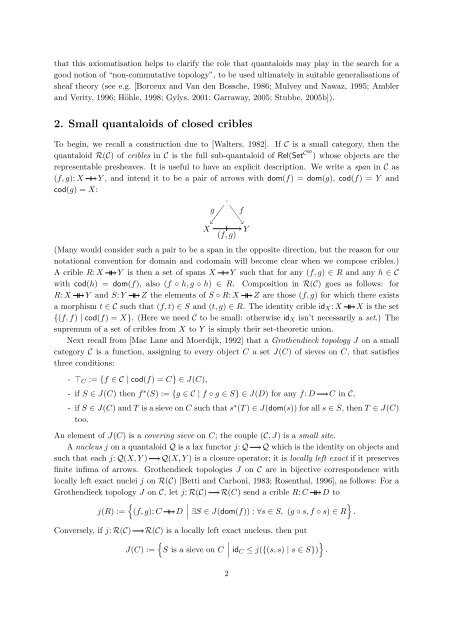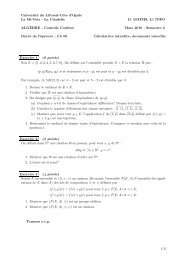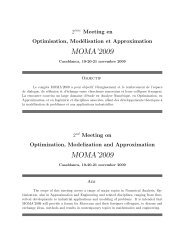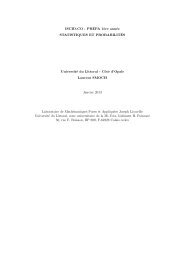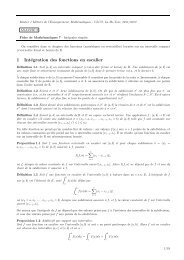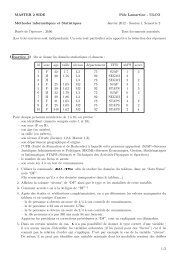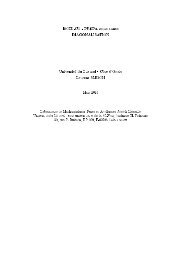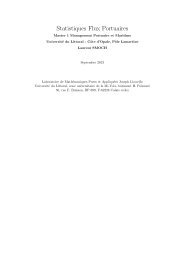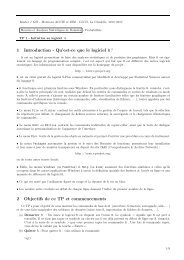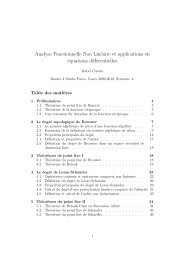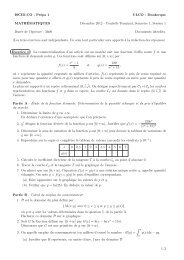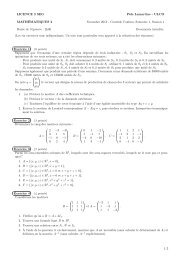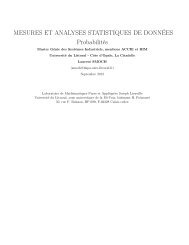download pdf - LMPA - Université du Littoral Côte d'Opale
download pdf - LMPA - Université du Littoral Côte d'Opale
download pdf - LMPA - Université du Littoral Côte d'Opale
Create successful ePaper yourself
Turn your PDF publications into a flip-book with our unique Google optimized e-Paper software.
that this axiomatisation helps to clarify the role that quantaloids may play in the search for agood notion of “non-commutative topology”, to be used ultimately in suitable generalisations ofsheaf theory (see e.g. [Borceux and Van den Bossche, 1986; Mulvey and Nawaz, 1995; Amblerand Verity, 1996; Höhle, 1998; Gylys, 2001; Garraway, 2005; Stubbe, 2005b]).2. Small quantaloids of closed criblesTo begin, we recall a construction <strong>du</strong>e to [Walters, 1982]. If C is a small category, then thequantaloid R(C) of cribles in C is the full sub-quantaloid of Rel(Set Cop ) whose objects are therepresentable presheaves. It is useful to have an explicit description. We write a span in C as(f, g): X Y , and intend it to be a pair of arrows with dom(f) = dom(g), cod(f) = Y andcod(g) = X:· g f X Y (f, g)(Many would consider such a pair to be a span in the opposite direction, but the reason for ournotational convention for domain and codomain will become clear when we compose cribles.)A crible R: X Y is then a set of spans X Y such that for any (f, g) ∈ R and any h ∈ Cwith cod(h) = dom(f), also (f ◦ h, g ◦ h) ∈ R. Composition in R(C) goes as follows: forR: X Y and S: Y Z the elements of S ◦ R: X Z are those (f, g) for which there existsa morphism t ∈ C such that (f, t) ∈ S and (t, g) ∈ R. The identity crible id X : X X is the set{(f, f) | cod(f) = X}. (Here we need C to be small: otherwise id X isn’t necessarily a set.) Thesupremum of a set of cribles from X to Y is simply their set-theoretic union.Next recall from [Mac Lane and Moerdijk, 1992] that a Grothendieck topology J on a smallcategory C is a function, assigning to every object C a set J(C) of sieves on C, that satisfiesthree conditions:- ⊤ C := {f ∈ C | cod(f) = C} ∈ J(C),- if S ∈ J(C) then f ∗ (S) := {g ∈ C | f ◦ g ∈ S} ∈ J(D) for any f: D C in C,- if S ∈ J(C) and T is a sieve on C such that s ∗ (T ) ∈ J(dom(s)) for all s ∈ S, then T ∈ J(C)too.An element of J(C) is a covering sieve on C; the couple (C, J) is a small site.A nucleus j on a quantaloid Q is a lax functor j: Q Q which is the identity on objects andsuch that each j: Q(X, Y ) Q(X, Y ) is a closure operator; it is locally left exact if it preservesfinite infima of arrows. Grothendieck topologies J on C are in bijective correspondence withlocally left exact nuclei j on R(C) [Betti and Carboni, 1983; Rosenthal, 1996], as follows: For aGrothendieck topology J on C, let j: R(C) R(C) send a crible R: C D to{}j(R) := (f, g): C D ∣ ∃S ∈ J(dom(f)) : ∀s ∈ S, (g ◦ s, f ◦ s) ∈ R .Conversely, if j: R(C) R(C) is a locally left exact nucleus, then put{}J(C) := S is a sieve on C ∣ id C ≤ j({(s, s) | s ∈ S}) .2


